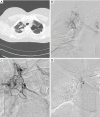Massive hemoptysis in pulmonary infections: bronchial artery embolization
- PMID: 30505533
- PMCID: PMC6218368
- DOI: 10.21037/jtd.2018.06.147
Massive hemoptysis in pulmonary infections: bronchial artery embolization
Conflict of interest statement
Conflicts of Interest: The authors have no conflicts of interest to declare.
Figures



Similar articles
-
Pulmonary artery access embolization in patients with massive hemoptysis in whom bronchial and/or nonbronchial systemic artery embolization is contraindicated.Cardiovasc Intervent Radiol. 2008 May-Jun;31(3):633-7. doi: 10.1007/s00270-007-9265-5. Epub 2008 Jan 3. Cardiovasc Intervent Radiol. 2008. PMID: 18175175
-
Bronchial Artery Embolization with Large Sized (700-900 µm) Tris-acryl Microspheres (Embosphere) for Massive Hemoptysis: Long-Term Results (Clinical Research).Cardiovasc Intervent Radiol. 2018 Feb;41(2):225-230. doi: 10.1007/s00270-017-1818-7. Epub 2017 Oct 24. Cardiovasc Intervent Radiol. 2018. PMID: 29067512
-
Massive hemoptysis due to pulmonary tuberculosis: control with bronchial artery embolization.Radiology. 1996 Sep;200(3):691-4. doi: 10.1148/radiology.200.3.8756916. Radiology. 1996. PMID: 8756916
-
[Successful embolization of bronchial artery in racemose hemangioma].Nihon Kyobu Shikkan Gakkai Zasshi. 1993 Feb;31(2):257-60. Nihon Kyobu Shikkan Gakkai Zasshi. 1993. PMID: 8515608 Review. Japanese.
-
Bronchial and nonbronchial systemic artery embolization for life-threatening hemoptysis: a comprehensive review.Radiographics. 2002 Nov-Dec;22(6):1395-409. doi: 10.1148/rg.226015180. Radiographics. 2002. PMID: 12432111 Review.
Cited by
-
Bronchial Artery Embolization for Life-Threatening Hemoptysis in COVID-19 Patients.Int J Angiol. 2022 May 19;33(4):307-314. doi: 10.1055/s-0042-1745839. eCollection 2024 Dec. Int J Angiol. 2022. PMID: 39502345 Free PMC article.
-
Preemptive non-selective bronchial artery angioembolization to reduce recurrence rate of hemoptysis.Multidiscip Respir Med. 2020 Dec 30;15(1):723. doi: 10.4081/mrm.2020.723. eCollection 2020 Jan 28. Multidiscip Respir Med. 2020. PMID: 33456774 Free PMC article.
-
Pulmonary Artery Bleed from an Eloesser flap.BMJ Case Rep. 2022 Apr 1;15(4):e245741. doi: 10.1136/bcr-2021-245741. BMJ Case Rep. 2022. PMID: 35365466 Free PMC article.
-
A retrospective analysis of risk factors in recurrent hemoptysis patients with non-bronchial systematic artery feeding.Ann Transl Med. 2020 Dec;8(23):1593. doi: 10.21037/atm-20-5544. Ann Transl Med. 2020. PMID: 33437792 Free PMC article.
-
Comparative Study of Diagnostic Efficacy of Single Phase-Computed Tomography Pulmonary Angiography and Dual Phase-Computed Tomography Pulmonary Angiography in the Diagnosis of Pulmonary Embolism.Front Cardiovasc Med. 2022 Feb 25;9:846805. doi: 10.3389/fcvm.2022.846805. eCollection 2022. Front Cardiovasc Med. 2022. PMID: 35282357 Free PMC article.
References
-
- Remy J, Voisin C, Ribet M, et al. Treatment, by embolization, of severe or repeated hemoptysis associated with systemic hypervascularization. Nouv Presse Med 1973;2:2060. - PubMed
LinkOut - more resources
Full Text Sources
